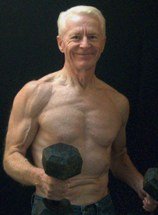Hi

April 1, 2019
In this newsletter . . .
Jelly Bellies,
Tape Measures
and Deep Breathing
The Urban Dictionary defines Dunlops Disease: “When your belly dunlops over your belt.” Funny. But at the same time deadly serious.
Here is what I mean: The Center for Disease Control and Prevention (CDC) reports that one-third of U.S. adults are not just overweight but obese. That’s not an exaggeration. Three out of ten Americans are obese! Other highly developed nations are similar. Six-pack abs are great. But somewhere between the two extremes of six-packs and Dunlops is the sweet spot where most people would like to be. For good health and appearance, firm abdominal muscles are required, along with the absence of a thick layer of fat covering them. If you are overweight or obese, how do you go about achieving a healthy bodyweight? Honestly, if it were easy no one would be fat. It requires a true desire to be fit and a degree of will power. There are two things you must do to reach
your goal. 1. Most important is to stop eating more food than you need. I know that sounds simplistic. But it is the crux of all weight loss methods. To reduce you must consistently consume fewer calories than your body requires for maintaining a current overweight condition. Programs such as Weight Watchers have been successful for many people. Or working with your doctor or a dietician might be the right path. Beware of diet pills (example) or quick-fix promises. Personally, I find hand-measurement for portion control eating is easy to follow and effective. I describe it here. 2. You must consistently exercise. Exercise is a key, but perhaps surprisingly it is in second place. If you don’t first get your calorie intake under control, all the exercise in the world will not burn off the excess fat. To do it right
takes a comprehensive approach. If you consistently reduce your calories but without exercising, yes, you can lose weight. However, without proper exercise too, you will end up thinner — but flabby. Here are two how-to-do-it places to get honest help. They are: Ab Exercise and a Trim Waistline. And, for beginners . . . go here. * * *The Cloth Tape Measure Of all the tools used for analyzing health and fitness, a simple cloth tape measure may be one of the best. Measuring the circumference of your waist will tell you more about your fitness than either scales or the Body Mass Index (BMI) formula. Jack LaLanne was fond of saying, “Your waistline is your lifeline.” Jack was ahead of
his time. Trainer and author Jon Benson (Fit Over 40) takes the tape measure method a step further, using a waistline-to-height formula as a predictor of heart disease. Mr. Benson tells us to measure right below the navel, and do not pull the tape measure tight. Write down that number in inches. Then measure your height (without shoes) in inches. Write that down too. Multiply your waist measurement by two. If the number is greater than your height, you are four times more likely to get heart disease. It’s more predictive than cholesterol tests, Benson says. The medical profession seems to agree. * * *Deep Breathing Are you a shallow breather? Look down at your belly for a moment. Does it rise as you inhale? If not, you are shallow breathing. In Yoga or the martial arts or any meditation or relaxation training, students are taught to focus on relaxed deep breathing as a means of calming the mind and body, which in turn lowers blood pressure and slows heart rates. A serious matter in the gym when it comes to breathing is a practice known as the “Valsalva maneuver.” Some experienced fitness people have never heard of the term, but unknowingly practice it or something like it. Maybe you’ve seen someone doing a heavy lift — while holding his breath — until red in the face, looking like his head is about to explode. He may not know the term for it, but he is practicing the Valsalva maneuver. Some coaches even teach it as a way of increasing intra-abdominal pressure, thereby providing more back support. But it can have dangerous consequences — especially for seniors. Blood pressure skyrockets when chest cavity pressure increases as you hold your breath. Dizziness or fainting can
result. Even a stroke, cerebral hemorrhage, or retinal detachments are possibilities. My advice is don’t do it. Breathe! Happy springtime in the northern hemisphere, Logan Senior Exercise Central
If you like the newsletter, we're making it easy to share it . . .



 
Newsletter Policy
The Gray Iron Fitness Newsletter is a free publication sent twice monthly to subscribers. The purpose is to provide honest and realistic fitness information for people age 50 and above.
I have never been paid or received compensation of any kind to write a positive review or endorse a product. If I say that I personally use a product or service, it is because I find value in it and have paid for it with my own money.
Like newspapers, magazines and television, this newsletter and my web site contain advertising and marketing links. Naturally, I am compensated for these.
The newsletter and web site provide information to help users establish and maintain a fitness lifestyle. But fitness information is not the same as fitness advice, which is the application of exercise and dietary practices to an individual's specific circumstances. Therefore, always consult with your physician for assurance that fitness information, and
your interpretation of it, is appropriate for you.Your comments and questions are always appreciated. Simply click on the "Reply" bottom.
Sincerely,
Logan Franklin
The Gray Iron Fitness Newsletter
www.senior-exercise-central.com
|



